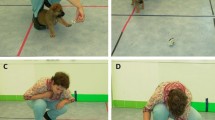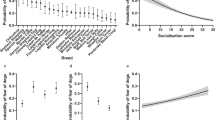Abstract
A researcher at the authors' institution needed to house adult bullfrogs (Rana catesbeiana) individually. The authors responded to this need by modifying 5-gallon plastic buckets to use for individual housing of bullfrogs. These buckets provided a simple, inexpensive housing system that successfully maintained healthy and behaviorally normal frogs. The authors describe the housing and husbandry of the bullfrogs in this individual housing situation and recommend it for use by others.
This is a preview of subscription content, access via your institution
Access options
Subscribe to this journal
We are sorry, but there is no personal subscription option available for your country.
Buy this article
- Purchase on Springer Link
- Instant access to full article PDF
Prices may be subject to local taxes which are calculated during checkout







Similar content being viewed by others
References
Veldhoen, N. & Helbing, C.C. Detection of environmental endocrine-disruptor effects on gene expression in live Rana catesbeiana tadpoles using a tail fin biopsy technique. Environ. Toxicol. Chem. 20, 2704–2708 (2001).
Rice, T.M., Oris, J.T. & Taylor, D.H. Effects on growth and changes in organ distribution of bullfrog larvae exposed to lead throughout metamorphosis. Bull. Environ. Contam. Toxicol. 68, 8–17 (2002).
Yamauchi, K. Prapunpoj, P. & Richardson, S.J. Effect of diethylstilbestrol on thyroid hormone binding to amphibian transthyretins. Gen. Comp. Endocrinol. 119, 329–339 (2000).
Mayer, L.P., Dyer, C.A. & Propper, C.R. Exposure to 4-tert-octylphenol accelerates sexual differentiation and disrupts expression of steroidogenic factor 1 in developing bullfrogs. Environ. Health Perspect. 111, 557–561 (2003).
O'Rourke, D.P. Amphibians used in research and teaching. ILAR J. 48, 183–187 (2007).
Daszak, P. et al. Emerging infectious diseases and amphibian population declines. Emerg. Infect. Dis. 5, 735–748 (1999).
Garner, T.W.J. et al. The emerging amphibian pathogen Batrachochytrium dendrobatidis globally infects introduced populations of the North American bullfrog, Rana catesbeiana. Biol. Lett. 2, 455–459 (2006).
Mazzoni, R. et al. Emerging pathogen of wild amphibians in frog (Rana catesbeiana) farmed for international trade. Emerg. Infect. Dis. 9, 995–998 (2003).
Nichols, D.K., Lamirande, E.W., Pessier, A.P. & Longcore, J.E. Experimental transmission of cutaneous chytridiomycosis in dendrobatid frogs. J. Wildl. Dis. 37, 1–11 (2001).
Weldon, C., du Preez, L.H., Hyatt, A.D., Muller, R. & Spears, R. Origin of the amphibian chytrid fungus. Emerg. Infect. Dis. 12, 2100–2105 (2004).
Daszak, P., Cunningham, A.A. & Hyatt, A.D. Infectious disease and amphibian population declines. Divers. Distrib. 9, 141–150 (2003).
Institute for Laboratory Animal Research. Guide for the Care and Use of Laboratory Animals (National Academies Press, Washington, DC, 1996).
Pough, F.H. Recommendations for the care of amphibians and reptiles in academic institutions. ILAR News 33, S1–S21 (1991).
Halliday, T.R. Amphibians. in UFAW Handbook on the Care & Management of Laboratory Animals 7th edn. (ed. Poole, T.) 90–102 (Wiley-Blackwell, Oxford, 1999).
Mylniczenko, N. Amphibians. in Manual of Exotic Pet Practice (eds. Mitchell, M.A. & Tully, T.N.) 73–111 (Saunders, St. Louis, 2008).
O'Rourke, D.P. & Schultz, T.W. Biology and diseases of amphibians. in Laboratory Animal Medicine 2nd edn. (eds. Fox, J.G., Anderson, L.C., Loew, F.M. & Quimby, F.W.) 793–826 (Academic, San Diego, 2002).
Mattison, C. The Care of Reptiles and Amphibians in Captivity 3rd edn. (Blandford, London, 1992).
Piotrowski, J.S., Annis, S.L. & Longcore, J.E. Physiology of Batrachochytrium dendrobatidis, a chytrid pathogen of amphibians. Mycologia 96, 9–15 (2004).
Wright, K.M. & Whitaker, B.R. eds. Amphibian Medicine and Captive Husbandry (Krieger Publishing Company, Malabar, FL, 2001).
Author information
Authors and Affiliations
Corresponding author
Rights and permissions
About this article
Cite this article
Alworth, L., Vazquez, V. A novel system for individually housing bullfrogs. Lab Anim 38, 329–333 (2009). https://doi.org/10.1038/laban1009-329
Received:
Accepted:
Issue Date:
DOI: https://doi.org/10.1038/laban1009-329



